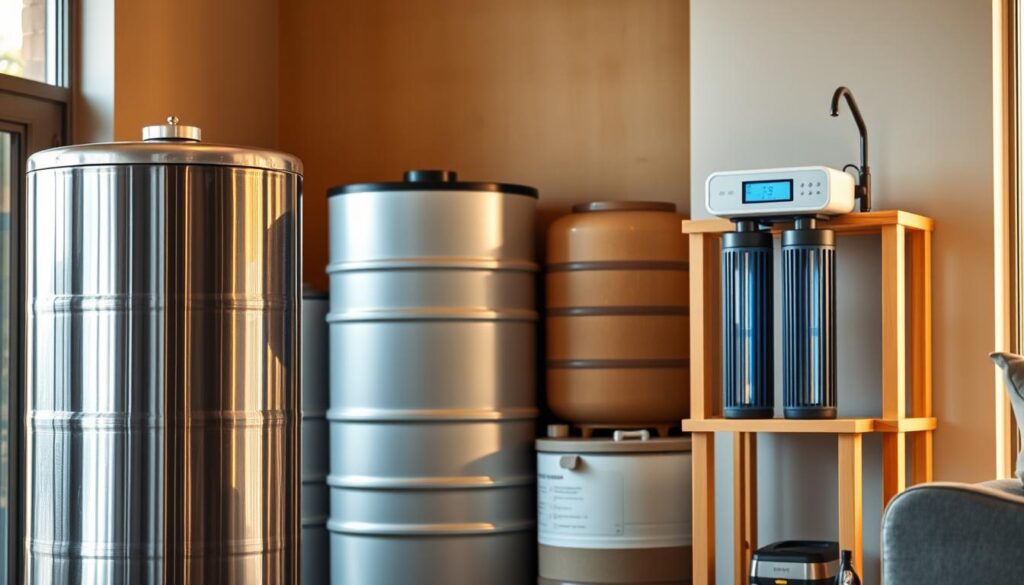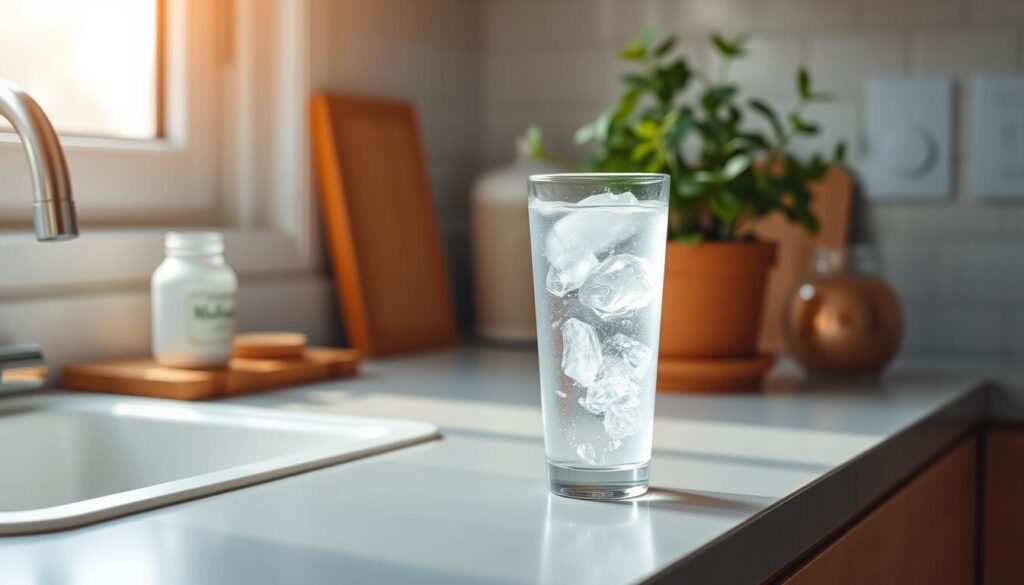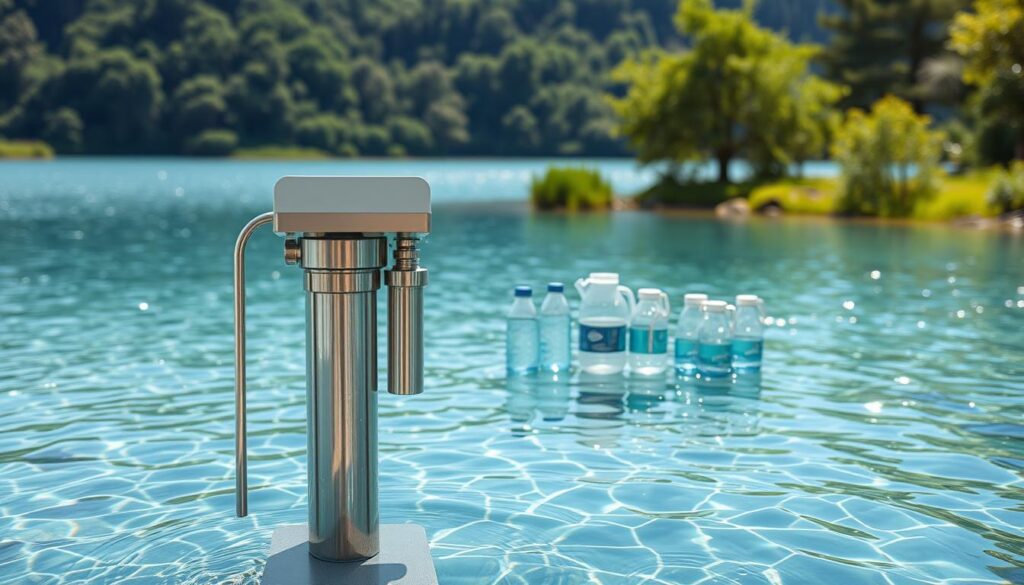Thinking about being ready at home, I see how key a good water storage system is. It’s not just for everyday use. It’s also for when emergencies or disasters hit.
The Department of Environmental Quality says to store 1 gallon per person per day for 2 weeks. This shows how important having enough clean water is for emergencies.
Having water stored can be a lifesaver during hurricanes, floods, or other disasters. It’s a simple way to keep my family safe.
Key Takeaways
- Store at least 1 gallon of water per person per day for 2 weeks.
- Having a reliable water storage system is key for emergencies.
- A good water supply can be a lifeline during disasters.
- Prepare your home with a simple yet effective water storage solution.
- Ensure your family’s well-being with a stored water supply.
Importance of Water Storage Solutions
Thinking about my water needs shows me how vital water storage is. Having a good water storage plan is key to keeping water flowing for our home.
Understanding Water Demand
A person who’s active needs to drink at least 2 quarts (1/2 gallon) of water daily. If it’s hot or I’m very active, I might need twice as much. Knowing how much water my household uses helps pick the right storage size and type.
Drinking water isn’t the only use. Cooking, cleaning, and staying clean also use a lot of water. By checking how much water we use every day, I can find a storage system that fits our needs.
The Benefits of Efficient Water Storage
Good water storage brings many perks, like lowering water bills and less need for city water. Storing water when it’s plentiful helps me not rely so much on outside water sources when it’s dry.
It also reduces the load on local water sources, helping us use water better. This is really important in places that often face drought or have limited water systems.
Emergency Preparedness
In emergencies or natural disasters, having a solid emergency water storage plan is essential. Portable water tanks are a big part of this, giving us clean water when we need it.
By choosing the right water storage, my family and I can be ready for anything. We’ll have enough water for drinking, cooking, and staying clean.
Types of Water Storage Solutions
There are many water storage solutions out there, each with its own benefits.
When looking at water storage for my home, I must consider the different systems available. Each one has its own strengths.
Rainwater Harvesting Systems
Rainwater harvesting collects and stores rainwater for later use. It helps save groundwater and reduces the need for municipal water. This method also lightens the load on stormwater drainage systems.
By using a rainwater harvesting system, I can use a natural resource for tasks like watering plants and flushing toilets.
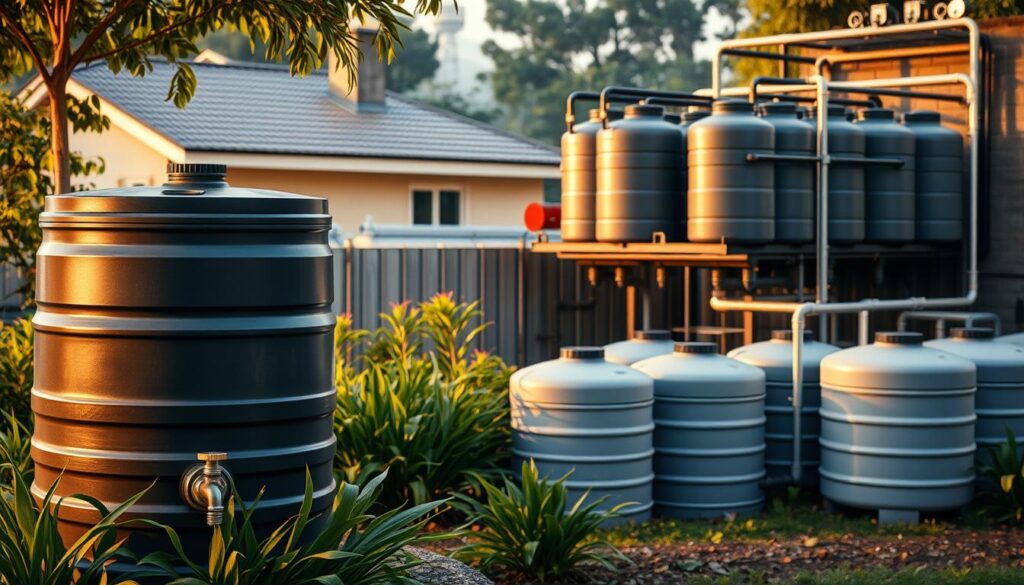
Water Tanks for Residential Use
Water tanks are a popular choice for storing water at home. They come in different sizes and materials like plastic, metal, and concrete. The right tank depends on space, budget, and how you plan to use it.
A bigger tank might be needed for bigger families or for storing water for emergencies.
- Plastic tanks are tough and don’t rust.
- Metal tanks are strong and can be used above or below ground.
- Concrete tanks last a long time and are good for storing a lot of water.
Portable Water Storage Containers
Portable containers are great for those who need flexible or temporary water storage. They’re perfect for camping, emergencies, or places where you can’t install a permanent tank. They come in various sizes and are often light and easy to carry.
Choosing the Right Water Tank
Choosing the right water tank for my home is important. I need to think about the material, size, and local rules. This ensures the tank fits my household’s needs well.
Material Considerations: Plastic vs. Metal
The tank’s material is key. Plastic tanks are durable and don’t rust, making them popular. Metal tanks are strong and good for big storage needs. A study says the material choice affects the tank’s life and upkeep.
“The material used for water storage tanks should be durable, non-toxic, and resistant to environmental factors.”
Size Requirements for My Household
Finding the right tank size is critical. I must look at my family’s water use. The number of family members, daily water use, and how we plan to use the water matter. A bigger family or one that uses water for gardening might need a bigger tank.
It’s also smart to look at factors to consider when buying a water storage tank. This helps me make the best choice.
Local Regulations and Codes
Before buying a tank, I must check local rules. I need to talk to local authorities about any tank rules in my area. Following these rules is important to avoid legal trouble.
Understanding local rules also helps me know the best practices for water storage. This way, I can pick a tank that meets my needs and follows local standards.
Installation of Water Storage Systems
Proper installation is key for water storage systems to work well and last long. I need to decide if I should do it myself or hire a pro.
DIY vs. Professional Installation
Choosing between DIY and a pro depends on the system’s complexity and my DIY skills. DIY can save money, but it takes a lot of time and knowledge. Professional installation means the job is done right and fast, but it costs more upfront.
As
“A well-installed water storage system is key for saving water and being ready for emergencies.”
This quote shows how important it is to get the installation right, whether I do it or hire someone.
Essential Tools for Installation
Having the right tools is vital, whether I install it myself or hire someone. I’ll need a level, wrench, and pipe cutters. 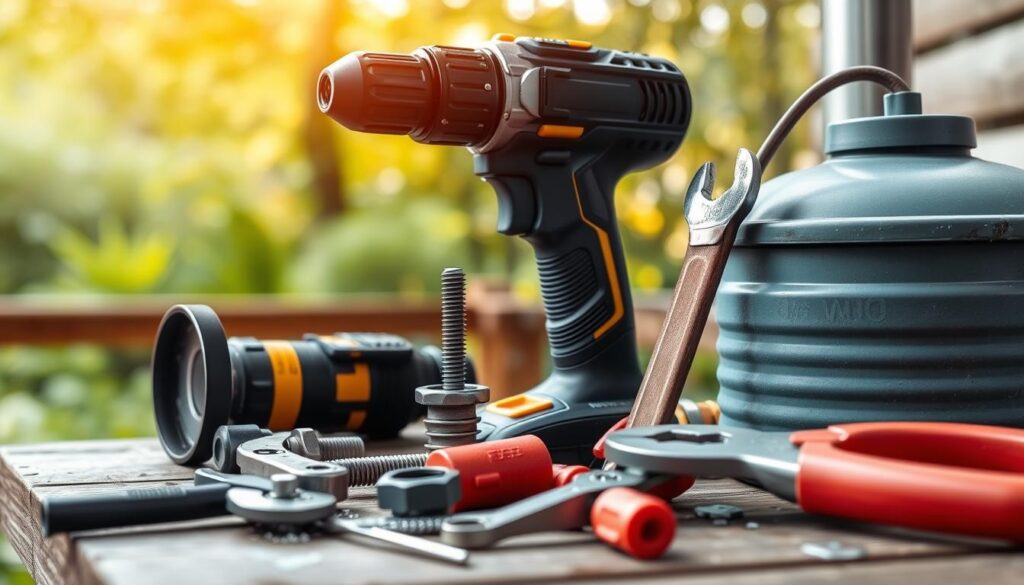
Common Installation Mistakes to Avoid
One big mistake is not checking the site conditions first. This includes making sure the ground is level and following local building codes. Another mistake is not testing the system after it’s installed to make sure it works right. Knowing these common mistakes can help me avoid them and ensure a good installation.
For outdoor systems, it’s also important to think about the environment. Things like sunlight and drainage can affect the system’s life and performance. Proper installation will help it last longer and work better.
Maintenance of Water Storage Solutions
To keep stored water safe and quality, regular upkeep is key. This means doing several important tasks to keep the water storage system in good shape.
Regular Inspection and Cleaning
Checking the system often is vital to spot problems early. Look for wear, damage, or contamination signs. Cleaning the storage system regularly is also important to remove sediment and stop algae or bacteria growth.
I suggest checking the water storage system at least twice a year. During these checks, I look for leaks, corrosion, or damage to the tank and fittings. Cleaning should be done as needed, based on usage and system condition.
Water Quality Testing
Testing water quality is a must in maintenance. It helps find any contamination or changes in water quality. I use water testing kits to check pH, turbidity, and contaminants.
Regular water quality testing makes sure the stored water is safe for use. This is true whether it’s for drinking, irrigation, or other uses.
Longevity Factors for Storage Systems
The life of a water storage system depends on several things. These include the material used, environmental conditions, and how well it’s maintained. For example, water storage bags made from durable, UV-resistant materials can last longer with proper care.
Things like sunlight, temperature changes, and contaminants can shorten a storage system’s life. By knowing these factors and taking the right steps, I can make my water storage last longer.
By sticking to these maintenance tips, I can keep my water storage solution working well and safely over time.
Cost of Water Storage Solutions
When looking at water storage solutions, cost and savings are key. It’s important to think about both the upfront cost and long-term savings. This helps in making a smart choice.
Initial Investment vs. Long-term Savings
The cost of starting a water storage system can be high. But, it’s worth it for the savings over time. For example, using rainwater can cut your water bills by half. Studies show households can save up to 50% on water bills by using rainwater for non-drinking needs.
Available Grants and Subsidies
There are grants and subsidies to help with the cost. Government programs and local incentives can make it easier. Some states even offer rebates for rainwater harvesting systems.
- Check with local authorities for available grants.
- Research state and federal programs that support water conservation.
- Consider consulting with a professional to identify applicable subsidies.
Comparing Different Options
When comparing water storage solutions, like water drums, consider several things. These include cost, how long they last, and how much upkeep they need. 
| Solution Type | Initial Cost | Long-term Savings |
|---|---|---|
| Rainwater Harvesting | $1,000 – $5,000 | Up to 50% on water bills |
| Water Drums | $100 – $500 | Variable, depending on usage |
Water Conservation Techniques
I’ve found many ways to save water, which is key for living sustainably. There are several strategies to cut down on water use. These methods can make a big difference.
Integrating Rainwater Harvesting
Using rainwater harvesting is a top water conservation technique. It collects and stores rainwater for tasks like watering plants or washing cars. This method lowers the need for groundwater and cuts down on stormwater runoff.
- Reduces water bills by using free rainwater
- Lessens the load on the city’s water supply
- Offers a natural, chemical-free water source for non-drinking uses
Using Greywater for Irrigation
Greywater irrigation is another helpful technique. Greywater comes from sinks, showers, and washing machines. Using it for irrigation cuts down household water use. It’s vital to treat greywater right to avoid health issues.
Drip Irrigation Systems
Drip irrigation systems are great for saving water. They send water straight to plant roots, cutting down on evaporation and runoff. This way, my garden or yard gets the right water without waste.
- Reduces water loss due to evaporation
- Boosts crop yield by watering roots directly
- Can be automated for easy use and efficiency
By using these water conservation techniques, I can lessen my water use. This helps make the future more sustainable.
Environmental Impact of Water Storage
Water storage is more than just saving water. It’s also about being kind to our planet. As I explore water storage options, I see how our choices affect the Earth.
How we store water matters a lot. It affects the materials we use and the local environment. So, it’s important to use sustainable practices in water storage to lessen harm.
Sustainable Practices in Water Storage
Using eco-friendly materials for water barrels is a big step. Choosing recycled plastic or long-lasting materials cuts down on waste and carbon emissions.
It’s also key to design and install water storage systems wisely. This means picking the right tank size to avoid wasting resources.
Reducing My Carbon Footprint
Choosing energy-efficient and sustainable water storage options helps me lower my carbon footprint. For example, rainwater harvesting saves water and cuts down on energy needed for treatment and transport.
Regular upkeep of my water storage system keeps it running well. This reduces any negative environmental effects.
Supporting Local Ecosystems
Water storage can help local ecosystems too. Harvesting rainwater, for instance, cuts down on stormwater runoff. This runoff often pollutes waterways and harms fish and plants.
Using stored water for plants also supports local biodiversity. It helps keep gardens and landscapes healthy, which is good for the environment.
Innovative Water Storage Technologies
The world of water storage is changing fast. New technologies are coming up to help save and use water better.
Smart Water Management Systems
Smart water management systems are a big step forward. They use sensors and IoT tech to watch water levels and find leaks. This helps people use water wisely, cutting down on waste and making things more efficient.
DIY Innovations in Water Storage
There are also cool DIY innovations for water storage. You can turn old containers into water tanks or make a rainwater catchment system. These ideas are cheap and help save water. Plus, they make you feel good about being self-sufficient.
Future Trends in Water Storage Solutions
Looking ahead, innovative water storage technologies will keep being key to solving water problems worldwide. New materials like graphene and nanomaterials will make water storage better. Also, AI and machine learning will help manage water more accurately.
By using these new techs, we can make our future more water-friendly. I’m looking forward to seeing how these advancements will help us and the planet.
Resources for Further Learning
As I explore water storage solutions, having reliable resources is key. These resources offer deep knowledge and guidance. They help those who want to learn more about water management and storage.
Recommended Literature
Books and guides give detailed insights into water storage and management. They cover rainwater harvesting and sustainable water practices. This information is useful for both homeowners and professionals.
Online Educational Resources
Online courses on water management are great for learning. Sites like Coursera and edX have courses on water conservation and sustainability. These courses are taught by experts in the field.
Community Programs and Workshops
Local workshops and community programs are also important. They teach about water storage and management. These programs offer hands-on learning and a chance to meet professionals.
Using these resources, I can keep learning and stay current with water storage and management news.
FAQ
What is the recommended amount of water to store per person per day?
You should store at least one gallon of water per person per day. This is for drinking, cooking, and hygiene. But, the amount needed can change based on your needs, the weather, and how active you are.
What are the benefits of using portable water tanks for emergency water storage?
Portable water tanks are great for storing water in emergencies. They are easy to move, set up fast, and give you clean water when you need it most.
How do rainwater harvesting systems work?
Rainwater harvesting systems catch and store rainwater from roofs or other surfaces. This water can be used for things like watering plants or flushing toilets. It helps save municipal water supplies.
What are the advantages of using collapsible water containers for water storage?
Collapsible water containers are light, easy to store, and quick to set up. They’re perfect for storing water in emergencies or for outdoor activities.
How often should I inspect and clean my water storage tank?
You should check and clean your water storage tank at least once a year. This keeps the water clean and prevents contamination.
What are the factors that affect the longevity of water storage systems?
The life of your water storage system depends on the material, how well you maintain it, sunlight exposure, and the environment. Regular checks and upkeep can make your system last longer.
Are there any financial incentives available for installing rainwater harvesting systems?
Yes, some governments and groups offer grants, subsidies, or tax breaks for installing rainwater systems. These can help lower the cost of starting up.
How can I ensure that my water storage solution complies with local regulations and codes?
To follow local rules, check with your local government or water authority. They can tell you what rules apply in your area. If you’re unsure, it’s best to talk to a professional.
What are the benefits of using water drums or water storage barrels for outdoor water storage?
Water drums or barrels are tough, easy to clean, and versatile. They’re great for storing water outside, making them useful for homes and businesses.
Can I use greywater for irrigation purposes?
Yes, you can use greywater for irrigation, like watering plants or gardens. Just make sure it’s treated and managed right to avoid contamination and harm to the environment.

